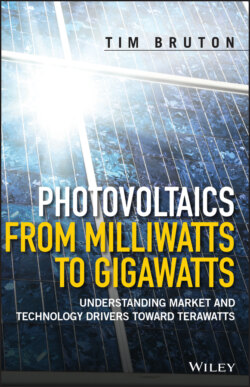Читать книгу Photovoltaics from Milliwatts to Gigawatts - Tim Bruton - Страница 11
Preface
ОглавлениеHarnessing the power of the sun has been a challenge to the human race for thousands of years. In the last quarter of the twentieth century and into the twenty‐first, the deployment of photovoltaic solar energy conversion assumed great importance. In its early years, it promised security of energy supply and price stability for many countries, and today it is a reliable route to carbon‐free energy production, a vital tool in the fight to halt manmade climate change. I have been highly privileged in being able to see this dramatic story evolve. I joined the embryonic BP Solar research team in August 1983 when the world market was a mere 20 megawatts and the future uncertain. In the subsequent 37 years, I have seen the technology grow from those early days when many applications were at the milliwatt scale to now, when single photovoltaic power stations of over 1 GWp are in operation. That this has happened is due to the interactions of many actors from the fields of science, manufacturing, and politics.
My ambition in this book is to relate how solar cells transitioned from a high‐cost, small‐volume, niche market to the global status they enjoy today. The text follows the developments in fundamental understanding, cell processing, and scale‐up of manufacturing (and subsequent drop‐off in product cost). I tend to use the conversion efficiency of solar cells from solar radiation to useful electricity as a criterion for assessing the progress of particular technologies, but with the caveat that high efficiency must be achieved cost‐effectively. Throughout the period in question, I was principally involved at BP Solar and then at NaREC in silicon solar cell design and manufacturing, although along the way I also had responsibilities for thin‐film silicon, cadmium telluride, III‐V cells, and concentrators. I have taken the opportunity to detail progress in these areas, but also to give my own explanation for why they have not been able to displace silicon as the prime solar cell material. The opinions expressed in this book are entirely my own and are not the views of any of my previous employers.
Throughout my career, I had the privilege of working with many able and dedicated people. In particular, I am indebted to Nigel Mason, Stephen Roberts, Daniel Cunningham, Keith Heasman, and Stephen Ransome for their steadfast support and friendship through the years. Following the merger of BP Solar with Solarex in 2000, I was able to connect with a different generation of pioneers, and it was inspiring to be able to share ideas with Steve Shea, John Wohlgemuth, and the late David Carlson. I have also enjoyed interactions with many others through supporting manufacturing in the United Kingdom, Spain, India, Australia, and the United States. There are many other colleagues from my time in BP Solar and NaREC who helped in innumerable ways, and space does not allow me to acknowledge them all by name. I must thank my wife, Margaret, who selflessly supported me throughout my career and without whom this book would not have been written.
